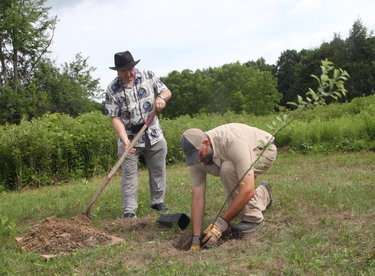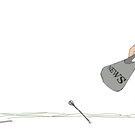Planting history
How do we learn our history and how should we celebrate it?
The town of Guilderland is off to an auspicious start in commemorating the 250th anniversary of the founding of our nation.
On a warm, sunny morning last week, July 8, a bevy of town officials and members of the media followed a grassy trail from the town’s community gardens to a cleared field where two apple saplings were carefully planted.
This was not a re-enactment of the shot heard round the world, marking the start of the American Revolutionary War. Rather, this was a re-enactment of a simple task that no doubt happened in our midst in 1775, if not on April 19 surely on days before and after.
“Everybody knows about the soldiers,” Donald Rittner told us before he picked up a shovel to plant.
It’s true, most Americans know about the soldiers who fought at Lexington and Concord. And, if the Guilderland 250th AmRev Committee has its way, people in town will soon know about the Battle of the Normanskill, the only Revolutionary battle fought in Albany County.
But, as Rittner stressed, the Revolution was about more than just the soldiers. The women who saw their men go off to war ran the farms they left behind and raised the children.
While Rittner hefted his shovel, David Jenkins, who oversees the town’s trails and historic buildings, knelt to carefully place the Golden Russet sapling in the hole.
Jenkins and Rittner both serve on Guilderland’s committee to celebrate the nation’s semiquincentennial and the town’s role in it, with Rittner as the chairman.
Rittner has been interested in history since he was a boy, skipping school to visit the Rensselaer County Historical Society Museum where, in the basement, he’d don a chainmail suit worn during the children’s crusades.
Instead of throwing him out, the museum’s director put his arm around the young Rittner, “poking my brain,” he said, with questions about history.
Rittner says you can’t understand where you are if you don’t know where you’ve been. He believes history is important and he has helped build a replica of a 1600s Dutch ship, the Onrust; served as the city of Albany’s archaeologist during the bicentennial; and a half-century ago pushed for the preservation of the Pine Bush.
On July 8, Ritter told us we should read Adriaen van der Donck’s “Description of New Netherland,” written in the 1600s by the Dutch lawyer who learned indigenous languages and helped mediate a treaty with the Mohawks.
In return for helping with the peace negotiations, Van der Donck was given a land patent for 24,000 acres on the mainland north of Manhattan. He was known the “Jonkheer,” and his former lands are now called Yonkers.
Rittner waxed eloquent on Van der Donck’s writing, describing the geography of the Hudson Valley, its native inhabitants, its climate, and its plants and animals.
“He suggested there should be a school of painting,” said Rittner and, of course, much later, in the mid-19th-Century, the Hudson River School was born.
Rittner also stressed the colonial history in America was Dutch before it was British. Since Peter Stuyvesant surrendered to the British in 1614, the American history most schoolchildren are taught is of 13 British colonies, which over time had other cultures added to it.
But the Dutch, who first settled the Hudson Valley, had a society composed of many cultures, unlike the Puritans with rigid religious rules that didn’t recognize outsiders, and also allowed for successful individuals to ascend, unlike the rigid class system of the British.
“We’re the oldest continuously settled area in the country …,” said Rittner. “This is the birthplace of American democracy.”
Rittner became interested several years ago in the Lost Apple Project, a not-for-profit in the Pacific Northwest that scours the countryside for abandoned orchards to bring antique varieties of apples back to life.
Its founder, David Benscoter, estimates that over 17,000 named varieties of apples once grew in North America, of which only about 4,500 survive. Today, according to the United States Apple Association, just 15 different varieties account for 90 percent of all production.
“One of the first things a farmer planted was apple trees,” said Rittner of the original European setters. The apples were used not just for eating but for making cider — more frequently drunk than water — and vinegar to pickle food for storage.
The area served as a “breadbasket” for the Revolutionary troops, with apples among the contributions.
The apple has stayed with us since the Revolution, too. John Chapman, son of a minuteman, was known as “Johnny Appleseed” because he planted apple trees across the frontier. Soldiers during World War II were famous for saying they were fighting for mom and apple pie.
Rittner said that Albany County was a pioneer in agricultural experimentation, citing Jesse Buel who, in the early 19th Century, grew 150 varieties of apples in his Albany Nursery, now the Pine Hills neighborhood. He introduced the Gravenstein apple in 1826.
The Clapper Flat apple originated in Bethlehem and the Slingerland, named for its originator, was raised in New Scotland in around 1830, Rittner’s research showed.
The Golden Russet, which was planted in the nascent Guilderland orchard — the trees donated by Allyssa and Connor Hardiman of the St. Lawrence Nurseries — originated in New York state in the first half of the 19th Century.
Rittner is hoping to get 100 heritage apple trees in the Guilderland orchard, including all 14 known New York heritage varieties.
He urges anyone that may have a heritage tree languishing on their property to submit a leaf for genetic analysis.
The committee envisions the town will host annual events at the orchard, including apple-picking, cider-making, and activities for children.
“I may not be alive long enough to see it,” said Rittner.
Indeed, that has long been the measure of a civilized man — someone who plants seeds not to benefit himself but rather to flourish for future generations.
So we commend this way of celebrating our history. It is inclusive, causing us to reflect not just on the soldiers who fought in the Revolution but also on those who kept the farms running, which included enslaved people, and gave food to the war effort.
The project also leads us to reflect on the inventiveness of those, like Buel, who created new kinds of apples and on the value in variety.
Further, Rittner’s reference to Van der Donck’s writing lets us understand the land we live on, not just from a Dutch perspective, but through the eyes of a European seeing not only the flora and fauna of untrammeled lands but, importantly, its native inhabitants and their cultures.
Our understanding of our history should be ever-evolving.
Guilderland’s supervisor, Peter Barber, told us as we walked the grassy path to the site of the future orchard that the original nearby historical marker noting the location of the Battle of the Normanskill along what is now Route 146 will stay in place. Alongside it will be a kiosk explaining that recent research has shown the battle was actually fought in a different place nearby.
This is as it should be. We need to acknowledge truths as we discover them. A kiosk with a cogent explanation will engage people in understanding how history is discovered.
David Jenkins may have said it best. Guilderland’s orchard, he said, will “put history in the hands of the people.”
“It is important to read about our past on placards and view relics behind glass,” his statement goes on, “but to smell the blossoms in the spring air and to touch and taste the varieties of apples that were grown 200 to 300 years ago in this area — that is living history.”
The heirloom orchard, to our mind, is a much better way to celebrate our history than, say, a military parade. It engages and teaches us. And the apple tree, being itself an immigrant, is a suitable symbol for the United States of America.


